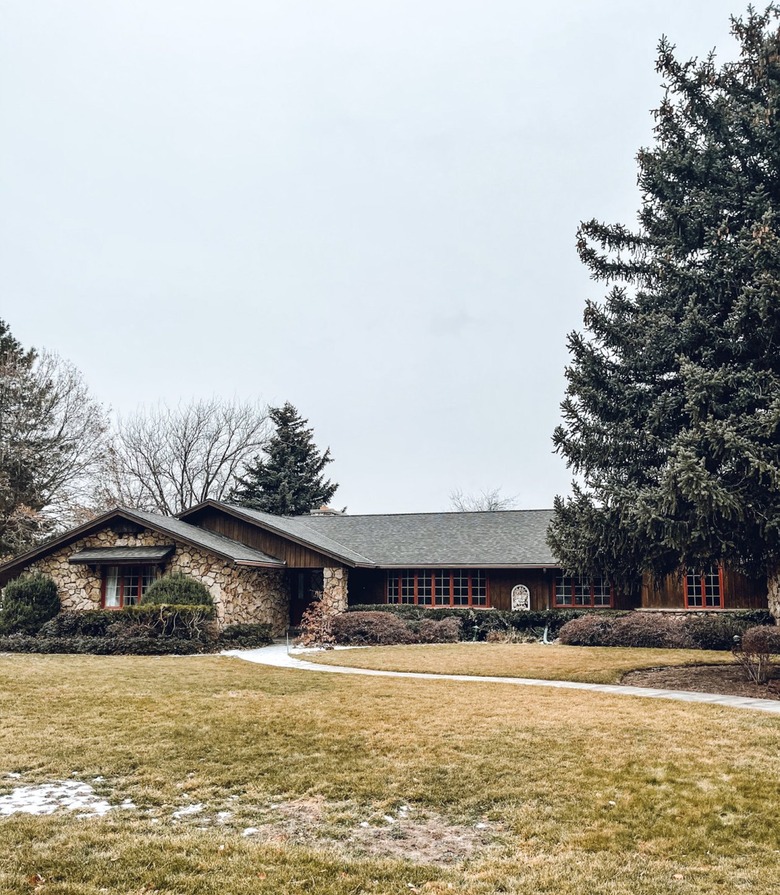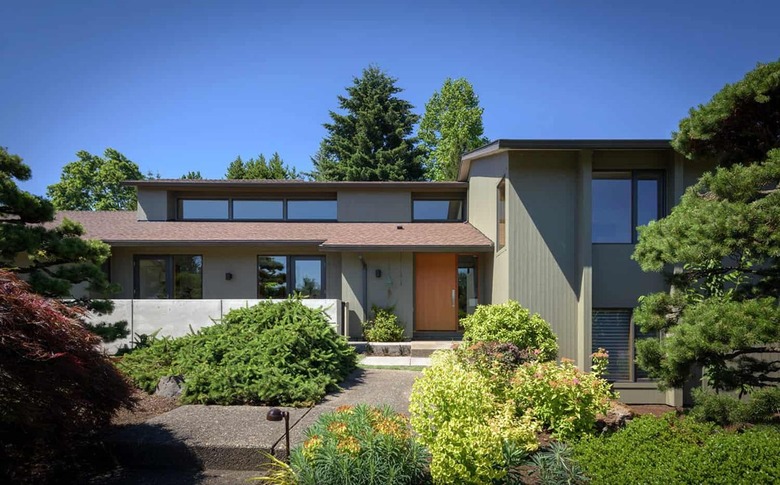These Were The Most Popular 1970s House Styles, According To Real Estate Agents
When you think of a house from the 1970s your mind likely conjures up images of shag carpet, funky flowered wallpaper, and most famously, wood paneling (which of course, has led to mass wood panel removal, and then later, wood panel whitewashing). But what architectural styles held all of these groovy interior decorations and dominated this far out decade?
Whether it's because of the success of Daisy Jones & The Six on Amazon Prime, or because of the practicality of the design, we're predicting that 1970s-style homes will be the next hot thing when it comes to real estate.
We spoke with two real estate pros to discover the hallmark architectural styles of the decade, why some trends from the 70s are making a comeback — and tips on scoring one of these gems from the disco era for yourself.
Colonial Revival
The 1970s brought us the Watergate scandal, leather moto jackets, and a new fresh take on the classic colonial style home. According to Jennifer Collins, Real Estate Agent with Compass, a colonial built in the 1970s was referred to as a "center hall" or "side hall."
"Typically you know the flow of the [center hall] house before you even step inside because they are so similar: walk in the front door, have a formal living room to your left and a dining room to your right, walk straight back down the hall and find the kitchen," she tells Hunker, adding that the second floor often has between three and five bedrooms, a shared hall bathroom, and a primary bedroom (normally with a bathroom of its own). "Some may have a screened in porch as well!"
The Classic Ranch
Ranch-style houses gained popularity post-WWII as affordable and practical one-level single-family homes, according to Collins. "The style evolved in the 70s to embrace some of the desirable highlights of mid-century features such as a vaulted ceiling in the family room with tongue and groove wood-clad ceilings and expansive windows," she says.
Their popularity also had a lot to do with the way this design made it easy to incorporate more outdoor features inside the home. "Elevating the views of nature was embraced in the 1970s as color palette of décor shifted to earthy tones."
The Split Level
The split-level home became popular because the style maximized square footage within a smaller footprint, offering various living options for families including the ever-popular rec room, says Collins. "And no rec room was complete without the notorious 'wood' paneling and perhaps a built-in bar."
Unfortunately the split level's popularity has waned over the years (you'll often hear buyers begrudging this layout on home renovation shows), and Collins says this style of home has fallen out of favor with today's buyers who often prefer homes with more vintage charm or modern design panache.
The Contemporary
Another popular style of the time was the contemporary (designer Lauren Liess's 1970s contemporary house is shown above), which Collins says had a totally different feel than colonials. "Inside the cathedral style ceilings, floor-to-ceiling brick or stone fireplaces, open tread staircases, steps to a sunken living room, and open floor plans [were] designed to wow you," she continues, adding that the second level often took what worked from colonials with the bedrooms on one level shared hall bathroom and primary bedroom en suite.
The Post and Beam
Jennifer Baptista, a licensed real estate agent out of Massachusetts says another popular design of the decade was a "very light" home called the post and beam. "When I say very light homes I mean they were very light in terms of the material used, such as a lot of interior glass and of course, that famous wood paneling," she says, adding that "clunky chunky design aesthetic was out," making room for streamlined designs that relied on materials such as brick, stone, and aluminum siding.
"Overall, the design aesthetic included slopes and peaks and was not very symmetrical," she continues. "For example, in a popular design style, one end of the home generally had a higher side [that] peaked to it."
1970s Interior Design Features
While a lot of the architectural designs from that time have stood the test of time, a lot of the actual décor inside the home has been lost, discarded, or renovated away. Collins says that means many of these homes may no longer have feature some of the little touches that made houses in the 70s feel like homes.
"Within the home the original décor will likely showcase harvest gold, avocado green, or copper brown 'it colors' and transport you back in time. Many of the bathrooms would've been covered in four by four wall tiles that matched the color of the sink, tub, and toilet," Collins says.
A kitchen from this time would've also been outfitted with the epitome of 1970's appliances: the all-in-one, double oven electric range by General Electric matching a side-by-side refrigerator and freezer. "Also matching the appliances will be the kitchen accessories: electric turkey carver, ice bucket, blender, and crockpot," Collins continues, adding that you'd likely find a "merry mushroom canister set" on the counter.
A lot of homeowners liked to pair bright colors and modern designs with natural aesthetics, according to Baptista. "For example, think faux fur rugs with stone side tables and bright wall paint," she says, adding that wood paneling also served as a way to bring more of nature inside. "Colored glass was also very popular, especially as a way to define the space in open floor plan living. It's like living inside a lava lamp!"
Why 70s Homes Are the Next Big Thing in Real Estate
Unlike those fashion choices of the past, Collins says there's a pretty practical reason why we may see people looking for 1970s architectural designs. "The 1970s colonial homes continue to be popular, not just because there is low housing inventory but because the layout is practical for a family," she says.
After the pandemic highlighted just how important it is to have a home that easily accommodates every member of your household, many people have been hyper aware of just how important their living spaces are.
"Like with all architectural designs, this design style ran its course," Baptista explains. But what was once old can become new again, if you have some vision. "If the house has good bones, and a lot of 1970s homes were indeed built well, you just found a needle in a haystack," she says.





